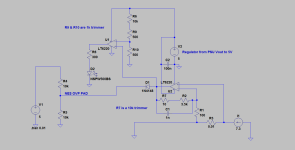NeilP
1 GW
Hi SBD
I can't comment on your schematic or the idea at all, but am wondering why you would want to do it when Cor has found a way to easily mod the NES via a much simpler approach. It just seems like re inventing the wheel with something more complicated..using extra external circuitry when a simple potentiometer will do the job..
Or is there something more to your board that will allow extra functionality. I am not knocking what you have done, just wondered what advantage doing something like that has over the R134 pot mod
Neil
I can't comment on your schematic or the idea at all, but am wondering why you would want to do it when Cor has found a way to easily mod the NES via a much simpler approach. It just seems like re inventing the wheel with something more complicated..using extra external circuitry when a simple potentiometer will do the job..
Or is there something more to your board that will allow extra functionality. I am not knocking what you have done, just wondered what advantage doing something like that has over the R134 pot mod
Neil


